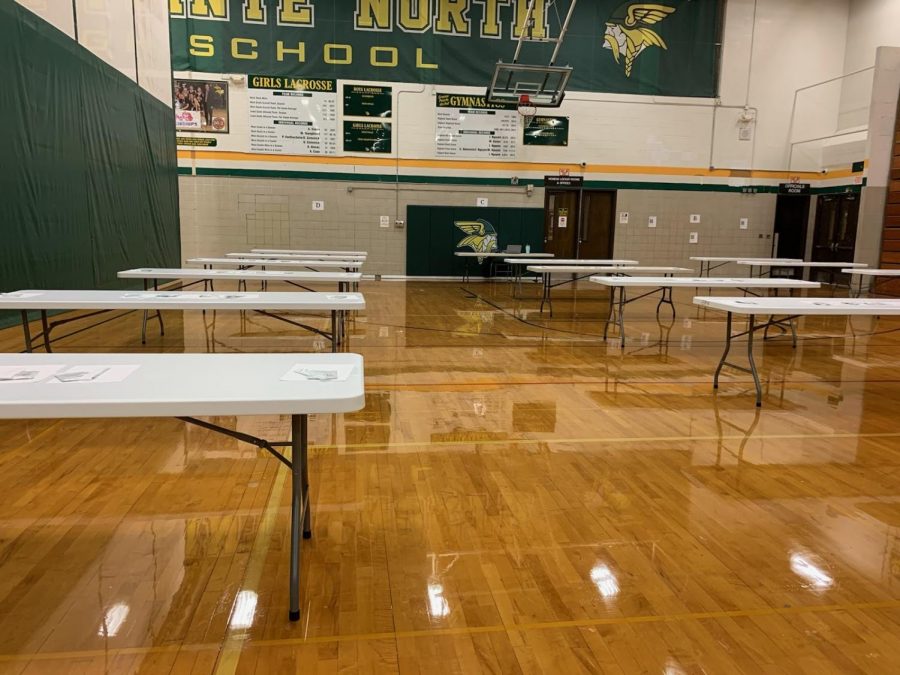Mandatory COVID-19 testing for athletes continues
Photo credit: Farrah Fasse
Athletic trainer Kierra Washington says that she and fellow athletic trainer Tara Winton arrive at school early Monday morning in order to set up the tables for athletes to test at. “…Right at seven o’clock, we get started, we have them open up their little testing kit that comes with their nasal swab, and we just direct them literally step by step of what they should do,” Washington said. “So they open up the testing kit, place it on the table, we have the coaches and administrators come over and put the drops in that help read the test, we have them swab their own nose, stick it in a test kit, and then they wait 15 minutes, and then we read the test.”
April 30, 2021
In order to mitigate the spread of COVID-19, rapid tests have been administered to traditional and OneGP Virtual spring athletes each Monday before and after school, respectively. The tests only take around 15 minutes to show results, allowing students to get to class quicker.
Even though going to school nearly an hour early for some teams may seem like an arduous task, varsity lacrosse coach Lauren Nixon believes that the before-school testing at the beginning of the week is beneficial for reducing close-contacts, and subsequently, quarantines.
“I personally believe that the testing has been effective for athletes who are asymptomatic or are showing symptoms of common allergies or a common cold,” Nixon said. “Since the testing is done on a Monday morning, it has allowed the school to then quarantine the students who test positive without quarantining any close contacts or very minimal close contacts.”
Athletic Trainers Kierra Washington and Tara Winton have carried out the testing process each Monday. They set up the tables and guide students through the self-administered test with step by step instructions. After the 15 minute waiting period, the tests are read by Washington, Winton or another faculty member.
Most of the results from tests have been negative so far, however, if there is a positive test, Winton says there’s a specific protocol that is followed.
“If there is a student athlete that has tested positive, we have administrators that are with us, such as the principal and athletic director,” Winton said. “If we come across one that is positive, then we go to that designated administrator and we tell them who it is what the result was. … That designated administrator … will call the parent, (and) they will pull the athlete out from amongst the group and stay with the athlete until the parent comes to pick up the child.”
However, the testing process has not been seamless, according to senior varsity softball player Emily McCloskey. She said that in addition to some teams who tested closer to the start time of school being late for class, there were also issues with the period when athletes waited to find out their test results.
“…It bothered me that we had to leave the building right away, after we took our test,” McCloskey said. “…There are people on our team that don’t have cars, so they are expected to either wait outside at 7:20, or have their parents pick them up to come drop them back off at school. I don’t think that’s fair or acceptable at all to expect a freshman or a sophomore to just wait outside because it’s cold in the morning.”
McCloskey said that while she believes that frequent COVID-19 testing has been instrumental in ensuring that teams can play their seasons to the fullest by catching cases early, there should still be other mitigation strategies in place to prevent any spread. She says that teams should be much more diligent with mask-wearing while playing, even if it is not required.
Despite the process of testing weekly being workheavy on the athletic trainers, Washington says it is worth it in the end to make sure spring athletes can play.
“But, it is keeping everybody safe,” Washington said. “So if we have to test every Monday, and we’re to keep kids safe and have spring sports, then that’s what we kind of have to do.”












